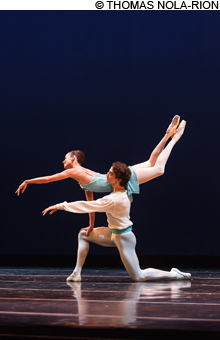
A NEO-CLASSICAL DELIGHT Putrius and Bauzys in Spring. |
Festival Ballet Providence's intimate in-studio performances, Up Close on Hope, have always offered full and varied programs of short works by local and guest choreographers, many of them new to Rhode Island audiences (and/or their work is new). This fall's series, which continues Fridays and Saturdays through November 3, reminds us of another facet of the series: it introduces us to many new Festival dancers.These newbies are sprinkled through the nine dances in the program. Ruth Whitney and Alan Alberto are soloists in Marius Petipa's Le Carneval de Venise and featured in Viktor Plotnikov's new piece Given, along with newcomer Casey Dolson. Whitney and Alberto execute classic steps with aplomb in Carneval: the spins, the lifts, the pirouettes, the jumps. What makes the extended pas de deux unusual is that four couples shadow the main pair; when Alberto takes his solo, the women frame his moves. When Whitney goes solo, the four men step out with lutes in hand and echo her turns across the stage. She also does some very tricky stepping variations while on point.
From the classical to the contemporary, Whitney and Alberto also succeed with Plotnikov's modern movements, his angular and unusual partnering, his spot-on timing. Dolson also does so; she adds an element of drama to a piece that projects somber moments as well as tender ones, with a baby doll passed among the five dancers, including Vilia Putrius and Mindaugas Bauzys as the older couple.
Back by popular request is Mark Harootian's homage to Regina Spektor, A Spektor of Things, set to three of her songs. The first movement features Festival veteran Jennifer Ricci (in her 22nd season), two newer dancers, Dylan Giles and Vincent Brewer, and two metal poles. Sometimes she is carried between them, stretcher-like; other times, she hangs by a knee and/or an arm, trapeze-like. She reaches toward the audience, desperate for solace; she struts past the pole-carriers, fed-up with their slim support for her sorrow. It's a terrific section.
But so are the other two movements, one a solo by Kirsten Evans, the other a duet with Tegan Rich and Ian Matysiak. Evans is graceful and expressive, even with the awkward, rag doll poses for her character. Rich steals the uptempo tune, her feet flexed when Matsyiak lifts her, eyes wide in surprise, hand-blowing kisses, her partner quite physically trying to push down her enthusiasm.
The most evocative piece was Gianni DiMarco's Casual Encounter, set to Vivaldi. Ricci and Ilya Burov meet each other on a bench and pursue their curiosity through flowing lifts, varied embraces (her body tucked around his middle as they spin), gentle hand gestures, even a pleading moment for the flirtation to last. It's wrenchingly romantic but not overdone.
Three more light-hearted pieces are quite different in style. George Birkadze's Dynamite, set to the electronic music of the Prodigy, is very fast and joyful, with almost jerky movements, legs sharply bent, even in lifts, and arms pointedly angled from elbows. Emily Loscocco stood out among the six dancers, and she returned to play a feisty Kate to Ilya Burov's determined Petruchio in Birkadze's Taming of the Shrew (also set to Vivaldi). The third is Egidijus Domeika's Spring, danced with an ease and lightness by Putrius and Bauzys that makes this neo-classical pas de deux a delight.